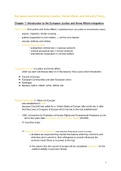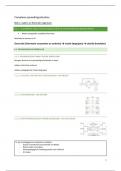European and International Justice, Home Affairs and Security Policy
Chapter 1: Introduction to the European Justice and Home Affairs integration
Policy areas from justice and home affairs (= beleidsterreinen van justitie en binnenlandse zaken)
- asylum, migration, border-crossing, …
- judicial cooperation in civil matters → not the core interest
- security, defense and military
- criminal law and policy:
° substantive criminal law (= materieel strafrecht)
° criminal procedural law (= formeel strafrecht)
° international cooperation in criminal matters
Cooperation levels on justice and home affairs
which we each will discuss later on in the lessons, this is just a short introduction
➔ Council of Europe
➔ European Communities and later European Union
➔ Schengen
➔ Benelux, NATO, OSCE, G7/G, OECD, UN
Council of Europe (= Raad van Europa)
was established in 1949
because Churchill had called for a ‘United States of Europe’ after world war II, after
that there was a Congress of Europe which has led to the real establishment
- 1950: Convention for Protection of Human Rights and Fundamental Freedoms (ECHR)
and a few years later: European Court of Human Rights (ECtHR)
- 47 countries today
⇒ Intergovernmental cooperation most important thing about council of europe
= all states are equal and they decide themselves what they commit to and
what they don't commit to, their willingness to commit influences the
common result (there is no power at the top)
⇒ the reason why the council of europe will be considered insufficient for the
political stability in post-war climate
1
, - Tasks and aims (doelen):
a. taking initiatives to enhance democracy and functioning of the rule of law
b. drafting and concluding treaties on concerning themes
c. promoting and supporting cultural diversity
d. structuring and stabilizing the democratic functioning in each state
- they use legal instruments such as conventions, resolutions and recommendations
convention = an agreement between states covering particular matters,
especially one less formal than a treaty, goes in three steps:
1. Negotiatores will discuss and sign it if they agree
2. Consult the population through the parliament, you’ll need an approval
3. You commit your country and the text becomes binding in your country
→ everything finds its basis in the mother conventions = principal, traditional
⇒ other options or actions were needed because the Council of Europe was not enough
European Union
has a large history, goes in different phases starting with the European Communities:
a. 1951: European Coal and Steel Community
b. 1957: European Atomic Energy Community
c. 1957: European Economic Community – treaty: TEC
→ Merger treaty aimed at uniting the three communities under one overarching
structure: the European Communities
→ there are a lot of threaties which have led to the establishment of the European
Union vb. Maastricht treaty (TEU), Amsterdam treaty (integrates Schengen), Nice treaty, …
Difference between:
- Intergovernmental cooperation = between governments, decisions are being made
unanimously by the governmental representatives
- Supranational cooperation = decisions are adopted by a majority vote and thus do
not need the acceptance of all participating states (but are binding for everyone)
2
,* European Coal and Steel Community (1951, ECSC)
→ common control on these industries
→ step towards permanent peace between the states of Western-Europe
→ control by the ‘High Authority’ = an independent supranational body
** European Atomic Energy Community (1957, Euratom)
*** European Economic Community (1957) is very relevant
1984: European Single Act has brought changes to the TEC by inserting this
keynotion of an internal market
→ focus on economic and monetary integration
→ realization of an internal or common market (= vrije markt)
= area without internal borders in which the free movement of goods,
capital, services and persons is guaranteed
- also brings a lot of criminality with it
- EEC has no competence as regards criminal law (except fraud)
3
, Chapter 2: Schengen
By the internal market (since the European Single Act) citizens of the EU could move from
one country to another but there is still border control for safety.
⇒ Free movement for EU citizens requires EU citizenship to be documented at the border
France and Germany abolished the controls with the Saarbrucken agreement (1984).
The Benelux already did that in 1960.
→ The 5 countries together signed the Schengen Agreement in 1990*
1990: Schengen Implementation Convention (SIC)
= established a free movement of persons, lifting controls at the internal borders but
the controls at the external borders were reinforced = versterkt
Different types of borders & movement.
Internal borders = binnengrens, tussen verschillende EU-landen
→ intra-schengen movement
External borders = buitengrens, van de EU landen met de niet-EU landen
→ external border movement
To support the entry of persons into the Schengen flanking measures were introduced:
● Carrier liability
= anyone bringing third-country nationals into the Schengen area is liable for
the repatriation costs when they are forced to go back → sanction
mechanism
● Obligation to register
accommodations must register overnight stays (name, citizenship, ID number)
● Handling asylum application & Eurodac
→ Schengen Convention established a mechanism to deal with an asylum
application ⇒ the country of first entry decides
→ link with the Dublin system and Eurodac (= an EU-wide database in which
they also needed to store fingerprints, 2000 but operational in 2003)
4





